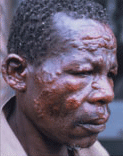To counter Iran’s emerging nuclear threat, we might look back to a little-known but highly effective Cold War collaboration between the U.S. and Soviet Union that defused international tensions and led to one of the world’s greatest humanitarian discoveries.
Today, we are on the verge of achieving the global eradication of polio. Most of this success can be attributed to the development of a safe and effective live oral polio vaccine, a discovery that first began during the 1950s in the Cincinnati laboratory of Dr. Albert Sabin. Few are aware, however, that Sabin’s initial discovery led to the full development of an actual polio vaccine only through a joint collaboration with Soviet virologists from 1956-1960.
In the years immediately following the Sputnik launch and the first successful detonation of the Soviet hydrogen bomb, arguably at the height of the Cold War, Sabin and a small group of Soviet virologists received back-channel diplomatic permission from their respective governments to collaborate on the successful development, manufacture, and large-scale clinical testing of the oral polio vaccine. Ultimately millions of Soviet children became the first vaccine recipients. The vaccine was deemed safe and effective so that these landmark studies first conducted in the U.S.S.R. led to the licensure, widespread acceptance, and ultimately the global use of the vaccine that has led us to the eradication of polio.
The example of two nations putting aside their ideologies for the monumental purpose of producing a lifesaving vaccine has potential relevance to the current situation in Iran. Today, the poorest people in Iran and elsewhere in the Middle East suffer from high rates of a number of devastating neglected tropical diseases, including leishmaniasis and brucellosis, worm infections such as echinococcosis and fascioliasis, and viral infections such as Crimean-Congo haemorrhagic fever and Rift Valley fever. Indeed almost all of the 60 million to 70 million people who live in poverty in the Middle East and North Africa region suffer from one or more of these. Such infections can affect not only the health of Middle Eastern nations, but they also trap people in poverty through their impact on child intellectual and physical development, pregnancy outcome, and agricultural worker productivity.
Neglected Tropical Diseases
Almost everyone in the world’s “bottom billion” has at least one of a dozen or so diseases that are mostly ignored by Western medicine and pharmaceutical companies. For descriptions and symptoms those named among researcher Peter Hotez’s neglected tropical diseases, read:
“List of Neglected Tropical Diseases.”

Iran, through its Razi Vaccine & Serum Research Institute (click here for the institute’s website in Farsi) together with some of the leading research institutes and medical universities with Tehran have reported on nascent efforts to develop vaccines for leishmaniasis and other neglected tropical diseases, but success on this front would be enormously accelerated with the added expertise of U.S. vaccine scientists and developers. While it could lead to a new generation of interventions to combat neglected tropical diseases in the region, any scientific collaboration between U.S. and Iranian vaccinologists is all but impossible in the current political environment.
Vaccines for neglected tropical diseases have little commercial interest because they disproportionately affect people living in poverty. I have referred to such products as “antipoverty vaccines” because of their potential for improving economic development as well as human health. Currently, anti-poverty vaccines are being developed mostly through just a few U.S.-based nonprofit product development partnerships, including our own with the Texas Children’s Hospital Center for Vaccine Development, which use industry practices to produce anti-poverty vaccines with a goal of improving global public health rather than reaping profits.
Linking Iranian and American vaccine developers and having them partner to develop anti-poverty vaccines could help to shape an effective blueprint for beginning a scientific dialogue with the Iranians. Ultimately, it could lead to lifesaving interventions that would benefit tens of millions of people throughout the Middle East and the rest of the world.
The U.S. Department of State and its Iranian counterpart should consider the opportunities created through such “scientific diplomacy.”
Earlier this year, Secretary of State Hillary Clinton called on better integration of “civilian power” in our U.S. foreign policy. Vaccine diplomacy represents a potential use of civilian power and a perhaps timely intervention for the Obama administration when tensions are at their highest. It would be worth recalling the similar complexities faced by the Eisenhower administration more than 50 years ago — and vaccine diplomacy’s positive role.




